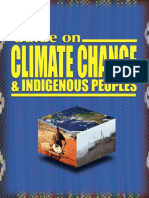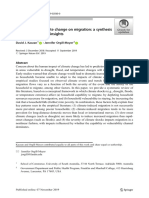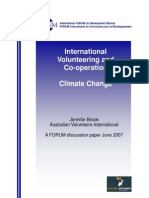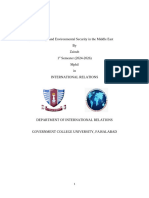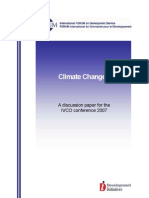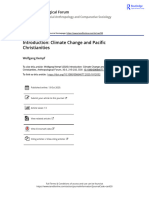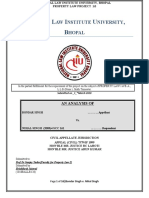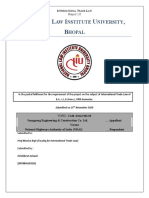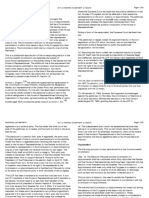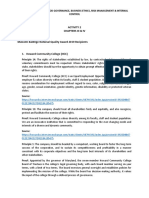N L I U, B: Ational AW Nstitute Niversity Hopal
N L I U, B: Ational AW Nstitute Niversity Hopal
Uploaded by
HRISHIKESH PRAKASH JAISWALCopyright:
Available Formats
N L I U, B: Ational AW Nstitute Niversity Hopal
N L I U, B: Ational AW Nstitute Niversity Hopal
Uploaded by
HRISHIKESH PRAKASH JAISWALOriginal Title
Copyright
Available Formats
Share this document
Did you find this document useful?
Is this content inappropriate?
Copyright:
Available Formats
N L I U, B: Ational AW Nstitute Niversity Hopal
N L I U, B: Ational AW Nstitute Niversity Hopal
Uploaded by
HRISHIKESH PRAKASH JAISWALCopyright:
Available Formats
Environmental Law
NATIONAL LAW INSTITUTE UNIVERSITY,
BHOPAL
In the partial fulfillment for the requirement of the project on the subject of Environmental Law of B.A.,
L.L.B (Hons.), Eighth Semester.
Submitted on 18th April 2022
TOPIC – Climate Change and Migration: An Analysis
Submitted to:
Prof (Dr.) Rajeev Khare {Faculty for Environmental Law}
Submitted by:
Hrishikesh Jaiswal (2018BALLB126)
CLIMATE CHANGE AND MIGRATION: AN ANALYSIS
Table of Contents
Table of Contents...........................................................................................................................2
Acknowledgement..........................................................................................................................2
Chapter I: Introduction................................................................................................................4
Chapter II: Research Methodology.............................................................................................6
Statement of Problem:.................................................................................................................6
Objectives:...................................................................................................................................6
Hypothesis:..................................................................................................................................6
Research Questions:.....................................................................................................................7
Methodology:...............................................................................................................................7
Review of Literature....................................................................................................................7
Chapter III- Climate change migration and related aspects.....................................................8
A short history of the debate........................................................................................................8
Tropical cyclones, torrential rains, and floods...........................................................................12
Sea-level rise..............................................................................................................................13
The multiple determinants of migration....................................................................................15
The social dimension of vulnerability.......................................................................................16
Possible policy orientations.......................................................................................................17
Chapter IV: Conclusion..............................................................................................................20
Bibliography.................................................................................................................................22
Page 2 of 23| NLIU BHOPAL
CLIMATE CHANGE AND MIGRATION: AN ANALYSIS
Acknowledgement
This paper has been made possible by the unconditional support of many people. I would like
to acknowledge and extend my heartfelt gratitude to Prof Rajeev Khare for guiding me
throughout the development of this paper into a coherent whole by providing helpful insights
and sharing her brilliant expertise. I would also like to thank the officials of Gyan Mandir,
NLIU, for providing material for this study. I am deeply indebted to my parents, seniors and
friends for all the moral support and encouragement.
Hrishikesh Jaiswal 2018BALLB126
Page 3 of 23| NLIU BHOPAL
CLIMATE CHANGE AND MIGRATION: AN ANALYSIS
Chapter I: Introduction
Climate change has become a major concern for the international community. Among its
consequences, its impact on migration is the object of increasing attention from both policy-
makers and researchers. Yet, knowledge in this field remains limited and fragmented: there are
uncertainties surrounding the actual mechanisms at stake, the number of persons affected, and
the geographical zones concerned; there are debates between those who stress the direct impact
of the environment on population flows and those who rather insist on the social, economic, and
political contexts in which such flows occur; different disciplines bring in their respective inputs
to the literature. Moreover, the available infor- mation is heterogeneous, as research outcomes
coexist with numerous “grey publications, such as policy reports, 1 advocacy brochures by IGOs
and NGOs,2 and conference proceedings.3
This article therefore provides an overview of the climate change-migration nexus. On the basis
of available empirical evidence, it investigates the key issues at stake, including the social and
political context in which the topic emerged; States’ policy responses and the views of different
institutional actors; critical perspectives on the actual relationship between the environment and
(forced) migration; the concepts and notions most adequate to address this relationship; gender
and human rights implications; as well as international law and policy orientations.
1
J. Barnett & M. Webber, Accommodating Migration to Promote Adaptation to Climate Change, Stockholm,
Commission on Climate Change and Development, 2009; Intergovernmental Panel on Climate Change (IPCC),
“Summary for Policymakers”, in S. Solomon et al. (eds.), Climate Change 2007: The Physical Science Basis.
Contribution of Working Group I to the Fourth Assessment Report of the Intergovernmental Panel on Climate
Change, Cambridge/New York, Cambridge University Press, 2007, available at: http://www.ipcc
.ch/publications_and_data/ar4/wg1/en/contents.html. Stern, The Economics of Climate Change, Cambridge,
Cambridge University Press, 2007
2
Christian Aid, Human Tide: The Real Migration Crisis, Christian Aid Report, May 2007, available at: http://
www.christianaid.org.uk/Images/human-tide.pdf (last visited 17 May 2022); K. Warner et al., In Search of Shelter:
Mapping the Effects of Climate Change on Human Migration and Displacement, CARE/CIESIN/United Nations
High Commissioner for Refugees (UNHCR)/United Nations University Institute for Environment and Human
Security (UNU-EHS)/World Bank, 2009, available at: http://www.ciesin.columbia.edu/ documents/clim-migr-
report-june09_media.pdf (last visited 17 Mar. 2022).
3
International Organization for Migration (IOM) & United Nations Population Fund (UNFPA), Expert
Seminar: Migration and the Environment, International Dialogue on Migration No. 10, Geneva, IOM,
2008, available at: http://www.reliefweb.int/rw/lib.nsf/db900sid/PANA-7FNH38/$file/IOM_june2008.
pdf?openelement (last visited 17 Mar. 2022); IOM, Migration, Climate Change and the Environment, IOM
Policy Brief, May 2009, available at: http://www.iom.int/jahia/webdav/shared/shared/mainsite/policy_and_
research/policy_documents/policy_brief_envmig.pdf (last visited 17 Mar. 2022); T. Afifi & J. Ja¨ger (eds.),
Environment, Forced Migration and Social Vulnerability, Bonn, Springer Verlag, 2010.
Page 4 of 23| NLIU BHOPAL
CLIMATE CHANGE AND MIGRATION: AN ANALYSIS
Two major interconnected arguments arise. The first regards the weight of environmental and
climatic factors in migration and their relationship to other push or pull factors, whether of a
social, political, or economic nature. Understanding the role of the environment in migration
dynamics implies analysing how and why people are vulnerable to climate change, as well as an
examination of the different strategies they develop to cope with (or adapt to) environmental
stress – migration being one among other such strategies. The second argument is about the
political framework in which such migration flows should take place and the manner in which to
treat the people who move in connection with environmental factors. This implies a discussion of
the possible protection to be granted to those in a situation of vulnerability and the
responsibilities of States and of the international community in providing such protection. The
two issues are deeply intertwined, as the extent to which the environment determines migration
is intimately connected to the status to be associated with the people concerned.4
This article is structured in the following way. It first provides a short historical overview of the
debate. It then discusses the impact on migration of three major environmental factors linked to
climate change (tropical cyclones, heavy rains, and floods; droughts and desertification; and sea-
level rise). The following sections explore the core issues that are raised by the relationship
between climate change and migration, namely the plurality of factors that shape migratory
dynamics, the social determinants of people’s vulnerability to climate change, the diversity in the
migration patterns associated with climate change, and issues of data collection and
methodology. The different concepts used by researchers in the field, along with their analytical
and political implications, are reviewed, which leads to a discussion of the legal implications of
environmental migration and the responsibilities of States. The last section explores the possible
policy orientations to address the climate change-migration nexus.
4
E.G. Ravenstein, “The Laws of Migration”, Journal of the Royal Statistical Society, 52(2), 1889, 286.
Page 5 of 23| NLIU BHOPAL
CLIMATE CHANGE AND MIGRATION: AN ANALYSIS
Chapter II: Research Methodology
Statement of Problem:
Climate change has become a major concern for the international community. Among its
consequences, its impact on migration is the object of increasing attention from both policy-
makers and researchers. Yet, knowledge in this field remains limited and fragmented. This article
therefore provides an overview of the climate change – migration nexus: on the basis of available
empirical findings, it investigates the key issues at stake, including the social and political
context in which the topic emerged; States’ policy responses and the views of different
institutional actors; critical perspectives on the actual relationship between the environment and
(forced) migration; the concepts and notions most adequate to address this relationship; gender
and human rights implications; as well as international law and policy orientations. Two major
interconnected arguments arise. The first regards the weight of environmental and climatic
factors in migration and their relationship to other push or pull factors, whether of a social,
political, or economic nature. The second is about the political framework in which such
migration flows should take place and the manner in which to treat the people who move in
connection with environmental factors. The two issues are deeply intertwined, as the extent to
which the environment determines migration is intimately connected to the status to be
associated with the people concerned
Objectives:
The study tries to provide an overview of the climate change-migration nexus. On the basis of
available empirical evidence, it will try to investigate the key issues at stake, including the social
and political context in which the topic emerged; States’ policy responses and the views of
different institutional actors; critical perspectives on the actual relationship between the
environment and (forced) migration; the concepts and notions most adequate to address this
relationship; gender and human rights implications; as well as international law and policy
orientations
Page 6 of 23| NLIU BHOPAL
CLIMATE CHANGE AND MIGRATION: AN ANALYSIS
Hypothesis:
Environmental migration is an issue that is commonly presented as “new” or as part of “future
trends”. But to the contrary, it is a very old-standing phenomenon
Research Questions:
A. How does Tropical cyclones, torrential rains, and floods Tropical cyclones, torrential
rains, and floods the migration pattern?
B. What are the impacts of drought and desertification on migration?
C. What is the relationship between sea level rise and migration ?
Methodology:
The work basically fulfils doctrinal research criteria as the possibility to have an empirical study
over the topic is very feeble. But the approach is analytical in nature.
Review of Literature
1. D.F. Sly & J. Tayman, “Ecological Approach to Migration Reexamined”, American
Sociological Review
2. E.C. Semple, Influences of Geographic Environment, New York, Henry Holt and
Company, 1911
3. E.G. Ravenstein, “The Laws of Migration”, Journal of the Royal Statistical Society
4. Olsson, “Distance and Human Interaction. A Migration Study”, Geografiska Annaler.
Series B, Human
Page 7 of 23| NLIU BHOPAL
CLIMATE CHANGE AND MIGRATION: AN ANALYSIS
Chapter III- Climate change migration and related
aspects
A short history of the debate
Environmental migration is an issue that is commonly presented as “new” or as part of “future
trends”. Yet, it is an old-standing phenomenon, as the history of the debate shows.
Environmental factors indeed ranked highly in the first systematic theories of migration. In 1889,
Ravenstein mentioned “unattractive climate” as having “produced and still producing currents of
migration” (along with “bad or oppressive laws, heavy taxation, uncongenial social
surroundings, and even compulsion” and, most importantly in his view, economic motivations).
The American geographer Ellen Churchill Semple later wrote that “the search for better land,
milder climate and easier conditions of living starts many a movement of people which, in view
of their purpose, necessarily leads them into an environment sharply contrasted to their original
habitat”.5 However, despite these early historical insights, references to the environment as an
explanatory factor were to progressively disappear from the migration literature over the course
of the 20th century. Indeed, core publica- tions such as J.W. Gregory, Donald R. Taft, or Julius
Isaac do not mention environmental factors. 6 The same applies to Zelinsky’s hypothesis on
“mobility transition”7 and to Stouffer’s “intervening opportunities” approach. The environment is
also absent from neo-classical economic theory,8 from geography,19 aswell as from the so-called
“ecological models” Since the end of the 1980s, there have been numerous theoretical
publications on international migration, but without any mention of environmental factors.1
Four main trends explain this decreasing interest in natural or environmen- tal factors. First,
according to a powerful Western-centric idea, technological progress would decrease the
5
E.C. Semple, Influences of Geographic Environment, New York, Henry Holt and Company, 1911, 143.
6
J.W. Gregory, Human Migration and the Future - A Study of the Causes, Effects & Control of Emigration,
London, Seeley, Service & Co., 1928; D.J. Taft, Human Migration: A Study of International Movements, New
York, The Ronald Press Company, 1936; J. Isaac, Economics of Migration, New York, Oxford University Press,
194
7
W. Zelinsky, “The Hypothesis of the Mobility Transition”, Geographical Review, 61, 1971, 219–249.
8
G. Olsson, “Distance and Human Interaction. A Migration Study”, Geografiska Annaler. Series B, Human
Geography, 47(1), 1965, 3–43.
9
D.F. Sly & J. Tayman, “Ecological Approach to Migration Reexamined”, American Sociological Review,
42(5), 1977, 783–795.
Page 8 of 23| NLIU BHOPAL
CLIMATE CHANGE AND MIGRATION: AN ANALYSIS
influence of nature on human life; Petersen thus views environmental migration as a “primitive”
form of migration bound to decline as human beings gradually increase their control over their
environ- ment.10 Second, environment-based explanations of migration were progres- sively
rejected for their supposedly deterministic nature, to the benefit of socio-cultural approaches or
Marxist/economic perspectives. A third reason is the rise of the economic paradigm in migration
theory: while already present in Ravenstein’s work, economic factors were given the most
central role, whether in Marxism-inspired or neoclassical research.11 Finally, forced migration
studies, while they could have included environmentally induced displacements, rather
developed upon a strong political premise according to which “States make refugees”.12
It is in this intellectual context that “environmental migrants” came back in the picture, as one of
the pressing issues raised by climate change. In the 1980s and beginning of the 1990s, a few
landmark publications raised the issue and provided alarmist estimates of the number of people
foreseen to move because of climate change; Norman Myers argued for example that up to 150
million environmental refugees were to be expected by the end of the 21st century.13
In 1990, the first United Nations (UN) intergovernmental report on climate change stated that
“the gravest effects of climate change may be those on human migration as millions will be
displaced”. And in 1994, paragraph 10.7 of the Programme of Action of the International
Conference on Population and Development (held in Cairo and widely understood as the first
major occurrence of migration issues in international debates) stated that “Governments are
encouraged to consider requests for migration from countries whose existence, according to
available scientific evidence, is imminently threatened by global warming and climate change”.14
10
Harris & Todaro, “Migration, Unemployment and Development”; S. Castles & G. Kosack, Immigrant
Workers and Class Structure in Western Europe, Oxford, Oxford University Press, 1973.
11
5 E. Marx, “The Social World of Refugees: A Conceptual Framework”, Journal of Refugee Studies, 3(3), 1990,
189–20
12
N. Myers, “Environmental Refugees in a Globally Warmed World”, Bioscience, 43, 1993, 752–761. See also, E.
El-Hinnawi, Environmental Refugees, Nairobi, United Nations Environmental Program, 1985; and J. Jacobson,
Environmental Refugees: A Yardstick for Habitability, Worldwatch Paper No. 86, Washington, D.C., Nov. 1988.
13
.McG. Tegart, G.W. Sheldon & D.C. Griffiths (eds.), Climate Change: The IPCC Impacts Assessment (1990).
Report prepared for Intergovernmental Panel on Climate Change by Working Group II, Canberra, Australian
Government Publishing Service, 1990, available at:
http://www.ipcc.ch/ipccreports/far/wg_II/ipcc_far_wg_II_full_report.pdf (last visited 17 Mar. 2022).
14
R. Black, Environmental Refugees: Myth or Reality?, New Issues in Refugee Research, Research Paper No. 34,
Geneva, UNHCR, Mar. 2001,
Page 9 of 23| NLIU BHOPAL
CLIMATE CHANGE AND MIGRATION: AN ANALYSIS
These early research and policy discussions were heavily embedded in a climate change agenda,
characterised by a strategy to raise awareness surrounding the potential impact of climate change
on migration – and on security at large. In this approach, “environmental migrants” were
portrayed as forced to leave their country and as moving exclusively for climate change-related
reasons, while the tone of the debate was future-oriented – hence favouring usually alarmist
predictions rather than empirical analysis of already-existing flows. This clearly clashed with
most migration researchers’ convictions and led to a long-standing divide between natural and
social scientists: while the former took for granted the interrelation between environmental
deterioration and migration and stressed the very high number of people concerned, the latter
considered the environment as, at most, one driver of migration among many others and were
very cautious regarding the estimates put forward.15 Moreover, alarmist predic- tions that aimed
at sensitizing Governments and public opinions rather con- tributed to further stigmatise
migrants from less developed States, while migration researchers reacted in a very defensive way
that did little to favour a sound debate between disciplines.
Today, it would seem that, although the debate still goes on, the disciplinary divide is gradually
being overcome: environmental scientists tend to be more cautious while migration specialists do
recognize the role of the natural envir- onment in migration dynamics. On the whole, most
scholars now dismiss the apocalyptic predictions that used to influence debates; there is also a
consensus on the fact that available evidence regarding the processes at stakes is still far fro
satisfactory. Yet, in a context in which climate change has become an overarching priority for a
wide range of actors worldwide, the vision of ‘climate refugees’ escaping environmental
disasters remains a powerful way to catch the imagination of the public – hence the numerous
initiatives taken by politicians, environmental activists, international organizations, and to a
certain extent, by lawyers, climatologists, or social scientists.16 Alarmist future predictions thus
remain popular; as Nicholas Stern wrote in his 2007 report on the economic consequences of
15
Warner et al., In Search of Shelter; F. Biermann & I. Boas, “Preparing for a Warmer World: Towards a Global
Governance System to Protect Climate Refugees”, Global Environmental Politics, 10(1), 2010, 60–88;
Collectif Argos, Climate Refugees, Boston, MIT Press, 2010.
16
6 J. Rodriguez et al., Annual Disaster Statistical Review 2008: The Numbers and Trends, Brussels, Centre for
Research on the Epidemiology of Disasters (CRED), 2009, available at: http://www.cred.be/sites/default/
files/ADSR_2008.pdf (last visited 17 Mar. 2022).
Page 10 of 23| NLIU BHOPAL
CLIMATE CHANGE AND MIGRATION: AN ANALYSIS
global warming: “Greater resource scarcity, desertification, risks of droughts and floods, and
rising sea-levels could drive many millions of people to migrate”.17
In sum, there are at least three lessons to be learnt from this history of the debate. First, the
controversy between natural and social scientists is deeply rooted in intellectual history and the
weight given to environmental factors in migration dynamics is therefore both a matter of “hard
facts” and of intellectual traditions; thus, a single historical migratory event can be initially
understood in environmental terms, and be later reframed in economic or political terms. 18 In this
respect, the current focus on environmental migration appears less as a “new” research issue than
as an expression of another paradigmatic shift. Second, this field of study is inherently political,
which means that research and statements regarding the climate change-migration nexus are very
hard to dissociate from the highly politicised debate on climate change itself. Third, as a result of
this specific history, this field of study is contested while poor inempirical evidence. While terms
such as “environmental migrants” have been growingly used over the last two decades, the
number of in-depth studies remains surprisingly low.
Before proceeding to the examination of the core issues raised by the climate change-migration
nexus, the next section therefore provides a review of the available knowledge on three main
environmental factors that are pre- dicted to grow in significance due to climate change in the
years to come and that are held for having an impact on migration: (1) the increase in strength
and frequency of tropical cyclones, heavy rains, and floods; (2) droughts and desert- ification;
and (3) sea-level rise (SLR).
Tropical cyclones, torrential rains, and floods
Tropical cyclones,19 storms, and floods are typical examples of rapid-onset phenomena impacting
on population displacement. The approximate estimates of the number of persons already
affected yearly by flooding (99 million between 2000 and 2008) and by tropical cyclones and
17
, S. Lonergan, “The Role of Environmental Degradation in Population Displacement”, Environmental Change and
Security Project Report, 4, 1998, 5–15; L.M. Hunter et al., “Environmental Hazards, Migration, and Race”,
Population & Environment, 25(1), 2003, 23–29;
18
I. Burton, R.W. Kates & G.F. White, The Environment as Hazard, New York, Guilford Press, 1993.
19
Paul, “Evidence Against Disaster-induced Migration”; A. Naik, E. Stigter & F. Laczko, Migration, Development
and Natural Disasters: Insights from the Indian Tsunami, Geneva, IOM, 2007.
Page 11 of 23| NLIU BHOPAL
CLIMATE CHANGE AND MIGRATION: AN ANALYSIS
storms (39 million) give an idea of the amplitude of the threat, 20 but the number of people who
would be affected by a climate change-induced increase of such disasters is very difficult to
estimate. No climate model is indeed able to accurately predict the exact localisation and timing
of such disasters and there is therefore no certainty as to whether or not the affected zones will be
densely populated.
According to a number of detailed studies,21 rapid onset phenomena lead overwhelmingly to
short-term internal displacements rather than long-term or long-distance migration. This is linked
to the fact that victims, who live mainly in poor countries, lack the resources to move. They tend
to stay where they live or to move only within a short distance. Moreover, many return and
reconstruct their homes in the disaster zone. A synthesis of results on the fate of victims of
natural disasters displaced in 18 sites showed (already 20 years ago) that there are few
exceptions to the strong propensity to return and to the weak potential oflong term migration. 22
Paradoxically, extreme events may even act as pull rather than push factors: in the case of the
Indian Ocean Tsunami in 2004, relatives moved to the area to find out whether their family had
been affected and to offer support; in addition, reconstruction projects increased the demand for
labour and attracted migrant workers from other areas; finally, new economic oppor- tunities
arose out of the presence of numerous aid-providing institutions. 23 This being said, macro-level
investigations that compare rates of emigration with local exposure to disasters lead to more
contrasted results. Several studies demonstrate that a high frequency of disasters (including
floods, storms, hurricanes, drought, and frost) encourages people to move away from their town
or country.24
Overall, the potential of tropical cyclones, floods, and torrential rains to provoke long-term and
long-distance migration, while ascertained, remains limited. As pointed out by Kniveton et al., 25
20
R. Reuveny, “Ecomigration and Violent Conflict: Case Studies and Public Policy Implications”, Human
Ecology, 36(1), 2008, 1–13.
21
35 R. Black & V. Robinson, Geography and Refugees, London, Belhaven, 1993.
22
6 J. Pedersen, “Drought, Migration and Population Growth in the Sahel: The Case of the Malian Gourma: 1900–
1991”, Population Studies, 49, 1995, 111–126.
23
7 M. Leighton, “Desertification and Migration”, in P.M. Johnson, K. Mayrand & M. Paquin (eds.), Governing
Global Desertification, London, Ashgate, 2006, 47.
24
A. De Haan, K. Brock & N Coulibaly, “Migration, Livelihoods and Institutions: Contrasting Patterns of Migration
in Mali”, The Journal of Development Studies, 38(5), 2002, 37–58
25
Kniveton et al., Climate Change and Migration, 34.
Page 12 of 23| NLIU BHOPAL
CLIMATE CHANGE AND MIGRATION: AN ANALYSIS
the level of vulnerability can be tremendously different from one region to another and it is only
if the affected society is highly dependent on the environment for livelihood and if social factors
exacerbate the impact of the disaster – as was typically the case with Hurricane Katrina 26 – that
significant migration takes place.
Sea-level rise
In contrast with the two environmental factors discussed so far (tropical cyclones-heavy rains-
floods and droughts-desertification), the link between SLR and migration appears much more
straightforward. Unlike most other hazards, SLR is virtually irreversible and manifests itself in a
more or less linear way over a long period of time. In the absence of new infrastructures such as
dykes, this would make definitive out-migration the only possible solu- tion, while allowing for
progressive and planned departures. SLR is also at the heart of some of the most dramatic and
publicised manifestations of climate change, including the possible disappearance of island
states.
Compared to other climatic events, SLR is a rather new phenomenon and the number of
available studies remains limited. Historical evidence nevertheless exists; for example, the
Chesapeake Bay islands on the Atlantic coast of the USA have experienced SLR since the mid-
19th century at rates of about 0.35 cm/year, which contributed, beside other factors, to the
abandonment of most of the islands by their resident populations in the early 20th century. The
consequences of SLR can be quite reliably predicted and localised, because the con- figuration of
coastlines, their altitude, and their population are simple to integrate into Geographical
Information Systems (GIS) that permit simulations and projections. It is therefore possible to
calculate – on a global scale – the
number of persons living in low elevation coastal zones and threatened by rising water levels,
higher tides, further-reaching waves, salinisation, or coastal erosion.
26
K. Munshi, “Networks in the Modern Economy: Mexican Migrants in the U.S. Labor Market”, Quarterly Journal
of Economics, 118(2), 2003, 549–599.
Page 13 of 23| NLIU BHOPAL
CLIMATE CHANGE AND MIGRATION: AN ANALYSIS
MacGranahan et al. define “low elevation coastal zones” as being situated at an altitude of less
than 10 meters.27 Even though these zones only account for 2.2 per cent of dry land on Earth,
they are presently home to 10.5 per cent of the world population – i.e. around 602 million
people, of which 438 million live in Asia and 246 million in the poorest countries of the world.
Anthoff provides a slightly lower figure, at 397 million people, which nevertheless remain
consid- erable.28 Yet, it would be premature to conclude that these people will all be forced to
evacuate their houses in the near future. The IPCC report evokes a 7-metre rise in sea-level
(consecutive to the possible melting of the Greenland ice cover), but this would occur over
several centuries or even millenaries. Of more concern is the scenario of future CO2 emissions
based on continuing economic growth with a moderation of fossil fuel use (scenario A1B of the
IPCC), which predicts an increase of 0.3 to 0.8 meters of the sea-level by the year 2300. 29 More
recent estimations show that this process might go significantly faster than previously thought.
On this basis, it seems reasonable to consider that populations living at an altitude of less than 1
meter above sea-level are directly vulnerable – and within a few decades. According to Anthoff
et al., 146 million people would be concerned here, 75 per cent of which are in the major river
deltas and estuaries in South Asia (Indus, Ganges-Brahmaputra, etc.) and East Asia (Mekong,
Yangtze, Pearl River, etc.).30 Although far less populated, certain islands (such as Tuvalu or the
Maldives) are the most threatened in the short-term, as they are situated only centimeters above
sea-level.
In sum, SLR probably constitutes the aspect of climate change that represents the clearest threat
in terms of long-term forced migration. But reaction to SLR is more complex than the mere
abandonment of lands. Migration can indeed happen long before an area really becomes
uninhabitable; and symmetrically, concerned populations can elaborate strategies of adaptation
and mitigation that may significantly postpone the necessity to leave. The recent decision by the
27
2 K. Van der Geest, North-South Migration in Ghana: What Role for the Environment?, International Conference
on Environment, Forced Migration and Social Vulnerability, Bonn, 9–11 Oct. 2008, available at:
http://geest.socsci.uva.nl/publications/vd_geest_2008a.pdf (last visited 17 Mar. 2022).
28
S.E. Findley, “Does Drought Increase Migration? A Study of Migration from Rural Mali during the 1983–85
Drought”, International Migration Review, 28(3), 1994, 539–553.
29
S. Henry, P. Boyle & E.F. Lambin, “Modelling Inter-provincial Migration in Burkina Faso: The Role of Socio-
demographic and Environmental Factors”, Applied Geography, 23(2–3), 2003, 115–136.
30
9 S. Henry, B. Schoumaker & C. Beauchemin, “The Impact of Rainfall on the First Out-Migration: A MultiLevel
Event-History Analysis in Burkina Faso”, Population and Environment, 25(5), 2004, 423–60
Page 14 of 23| NLIU BHOPAL
CLIMATE CHANGE AND MIGRATION: AN ANALYSIS
Dutch Government to improve its dyke’s protection system illustrates that financial resources
constitute a key factor in this respect.31
The multiple determinants of migration
The studies reviewed above highlight the complexity of the relationship between environmental
factors and migration and the fact that climate change is only one
factor among several others in explaining migration dynamics. In its simplest form, this refers to
the fact that any migratory movement is the product of several converging factors and that
environmental stress is always mixed with other causes, which may include economic constraints
or opportunities, social networks, political context, etc.
Moreover, factors fostering mobility are not only numerous, but also inter- twined. For example,
environmental change can generate health problems or food insecurity, which may in turn foster
migration. In such cases, identifying the ‘primary’ cause of migration is probably impossible, as
all causes may mutually reinforce each other. Environmental factors may also play a greater role
if they emerge in a context already characterised by political, demographic, economic, or social
tensions; climate change would thus be an additional burden, which can have a multiplier effect.
In other words, climate change is unlikely to trigger migration in wealthy and democratic
societies, which echoes Amartya Sen’s well-known work on famines, according to which these
are due less to environmental factors than to ill-founded political choices. 32 Environmental and
non-environmental factors can also interact in a step-by-step manner: if people have already
moved for predominantly economic reasons, they could be more likely to move again because of
climate change.
Discussing multi-causality therefore implies acknowledging the non-direct relationship between
climate change and migration, and the factors that mediate between the two. Climate change is
clearly a complex environmental process that does not have uniform consequences everywhere;
and societies have always had to adapt to changing environmental contexts – a multifaceted
31
A.K. Sen, Poverty and Famines: An Essay on Entitlement and Deprivation, Oxford, Clarendon Press, 198
32
P. Kabat et al., “Dutch Coasts in Transition”, Nature Geoscience, 2, 2009, 450–452
Page 15 of 23| NLIU BHOPAL
CLIMATE CHANGE AND MIGRATION: AN ANALYSIS
process of techno- logical, organizational, institutional, socio-economic, and cultural nature that
is likely to be just as complex as climate change itself. The number of variables is therefore
important, leading to high uncertainty and local variability.33
Policy-wise, multi-causality implies that States are unlikely to suddenly witness the arrival of
“environmental migrants”, as policy-makers sometimes seem to believe. To a large extent, future
migration flows will resemble current ones – at least from the perspective of receiving States in
the developed world. This is not to say that climate change has no impact, but rather that its
impact will be difficult to identify at first sight.34
The social dimension of vulnerability
The mediating function of social factors in the relationship between climate change and
migration points to the fact that people do not have access to the same resources when it comes
to reacting or adapting to environmental change. Vulnerability is therefore shaped by a wide
range of social variables that deter- mine people’s exposure to climate change. From a social
sciences perspective, this would seem to go without saying; yet, studies on the climate change-
migration nexus have long privileged top-down approaches in which so-called“hotspots” are
identified and mechanically understood as places where migration will occur – regardless of
“from below” considerations on the ways in which people will react and adapt. This is manifest
in many of the available maps on the topic, in which one can see the geographical zones likely to
be affected by climate change – but which say nothing of the social context.35
This includes for example gender, as changes in livelihood patterns affect men and women
differently, not only because of their different social positions, but also because gender is known
to influence the perception of risks (which is a crucial variable in migration strategies), as well as
the way people experience displacement. Another core variable in the construction of
vulnerability is of course class resources and wealth. Climate change affects disproportionally
33
R. Zetter, “The Role of Legal and Normative Frameworks for the Protection of Environmentally Displaced
People”, in F. Laczko & C. Aghazarm (eds.), Migration, Environment and Climate Change: Assessing the Evidence,
Geneva, IOM, 2009, 400.
34
L. Cambre´zy, Re´fugie´s et Exile´s: Crise des Socie´te´s, Crise des Territoires, Paris, Editions des Archives
Contemporaines, 2001.
35
Hugo, Migration, Development and Environment, 31.
Page 16 of 23| NLIU BHOPAL
CLIMATE CHANGE AND MIGRATION: AN ANALYSIS
poor agrarian communities, precisely those that have the least resources to leave their home. The
consequences of climate change thus vary according to the context, as the same environmental
factor will have different impacts according to the characteristics of the people it affects. It
follows that environmental degradation does not mechanically lead to displacement and that one
should resist the “tendency to equate populations at risk with population displacement”.36
Possible policy orientations
What are the policies that have been elaborated to respond to environmentally- induced
migration? And what are the policy orientations that could be envisaged to address the
challenges raised by the movement of people in a context of environmental change? Given the
heterogeneity in the types of climate stress that can foster migration, it is worth distinguishing
between different kinds of policy options.
First, there is the case of disasters and sudden climatic events. There have always been typhoons,
floods, or other natural catastrophes and most, if not all, regions of the world have experienced
the challenge of addressing the situations of the persons concerned. The problem lies in the
efficiency of the already existing mechanisms, especially if one assumes that climate change will
increase the frequency and/or intensity of some kinds of disasters – thus putting humani- tarian
efforts under further stress. This calls for reinforcing rescue mechanisms and, in the case of less
developed countries, for greater international solidarity, not least in making the necessary funds
available. This is one of the raison d’ˆetre, at the international level, of the United Nations
Disaster Assessment and Coordination (UNDAC) teams, managed by the UN Office for the
Coordination of Humanitarian Affairs (OCHA). Overall, the main objective should therefore be
to make a more extensive use of existing policy mechanisms and to adapt them to the specific
challenges raised by climate change.
Yet, one should keep in mind that the impact of climate change on migra- tion will also manifest
itself through much less sudden events. All too often, Governments and policy-makers seem to
react above all to disasters that force people to leave overnight; this applies to some of the most
documented cases of environmental migration, like the 2004 Asian Tsunami and the 2005
36
UN, Recommendations on Statistics of International Migration, New York, UN, 1998.
Page 17 of 23| NLIU BHOPAL
CLIMATE CHANGE AND MIGRATION: AN ANALYSIS
Hurricane Katrina in New Orleans. By contrast, the “silent crisis” fuelled by progressive
environmental change, while affecting potentially very high numbers of people, is the object of
much less policy attention. In some extreme cases, resettlement may constitute the appropriate
policy, in order to enable large numbers of people to leave their home on a permanent basis. But
these are not new policies either as resettlement has regularly been implemented in other
contexts, especially in relation to large scale infrastructure projects such as dams. Again
therefore, the relevant policy approach would be to improve existing policy options, through
increased funding and international cooperation.37
This being said, resettlement is not an option for all the people concerned by progressive
manifestations of climate change. There is therefore a need to envisage a much broader range of
responses, to address the multifaceted challenges 38 raised by slow environmental deterioration.
At the local level, this could for example include measures to diversify economic activities in
order to enable people to better adapt to climate change. More broadly, this would call for
incorporating the migration-climate change relationship in existing fields of policy that have so
far not only tended to ignore migration, but have also remained quite separate from each other.
These notably include development strategies and humanitarian interventions, two well
established fields of efforts at all levels (national, regional, and international), but that have so far
dedicated little energy to climate change, and even less to migration.39
In the same vein, one should note that environmental migration is also a matter for migration
policy at large. If, as argued, environmental factors exacer- bate already existing push factors in
less developed countries, more appropriate migration policies could probably accommodate part
of “environmental migra- tion” through classical schemes such as economic migration
programmes. IOM thus notes that “the international community is, in fact, ignoring labour
37
E. Mooney, “The Concept of Internal Displacement and the Case for Internally Displaced Persons as a Category
of Concern”, Refugee Survey Quarterly, 24(3), 2005, 9–26.
38
W. Ka¨lin, “The Climate Change Displacement Nexus”, ECOSOC Panel on Disaster Risk Reduction and
Preparedness: Addressing the Humanitarian Consequences of Natural Disasters, 16 Jul. 2008, available at:
http://www.brookings.edu/speeches/2008/0716_climate_change_kalin.aspx (last visited 17 Mar. 2022).
39
D. Kniveton et al., “Challenges and Approaches to Measuring the Migration-Environment Nexus”, in F. Laczko &
C. Aghazarm (eds.), Migration, Environment and Climate Change: Assessing the Evidence, Geneva, IOM, 2009,
41–111; R.E. Bilsborrow, “Collecting Data on the Migration-Environment Nexus”, in F. Laczko & C. Aghazarm
(eds.), Migration, Environment and Climate Change: Assessing the Evidence, Geneva, IOM, 2009, 115–196; E.
Piguet, “Linking Climate Change, Environmental Degradation and Migration: a Methodolgical Overview”, Wiley
Interdisciplinary Reviews: Climate Change, 1(4), 2010, 517524.
Page 18 of 23| NLIU BHOPAL
CLIMATE CHANGE AND MIGRATION: AN ANALYSIS
mobility as a coping strategy for climate stress”.74 This echoes the numerous calls for more
realistic and flexible approaches to migration that have been launched in recent years.75 This
also implies strengthening the legal framework in which international migration takes place,
possibly through existing norms such as the UN Convention on Migrant Workers’ Rights.40
This discussion highlights the fact that, even if environmental migration is regularly presented as
a “new” challenge requiring “new” responses, there is actually a number of existing policy fields
that can be relied upon to address the challenges it raises, including development strategy,
humanitarian affairs, post-disaster interventions, or immigration and admission policies. This is
not to say that new normative or policy instruments are irrelevant; rather, it means that new
instruments may not be a prior necessity to address the needs of the populations at risk and that
an absence of consensus on the desirability of such new standards does not imply that nothing
can be done.41
40
R. Cholewinski, P. de Guchteneire & A. Pe´coud (eds.), Migration and Human Rights. The United Nations
Convention on Migrant Workers’ Rights, Cambridge/Paris, Cambridge University Press/UNESCO Publishing,
2009.
41
United Nations Development Program (UNDP), Human Development Report 2009. Overcoming Barriers:
Human Mobility and Development, New York, UNDP, 2009, available at: http://hdr.undp.org/en/media/
HDR_2009_EN_Complete.pdf (last visited 17 Mar. 2022). See also A. Pe´coud & P. de Guchteneire,
Migration without Borders: Essays on the Free Movement of People, Oxford/Paris, Berghahn/UNESCO
Publishing, 2007
Page 19 of 23| NLIU BHOPAL
CLIMATE CHANGE AND MIGRATION: AN ANALYSIS
Chapter IV: Conclusion
Climate change does have consequences in terms of human migration and mobility, and its
impact can be expected to increase. But, given the complexity of the relationship between
environmental change and migration, it is worth recalling that climatic or natural hazards do not
automatically lead to displacements. Another core argument of this article is that migration is an
adaptation strategy in itself; it is not necessarily the worst scenario and should not be seen as an
intrinsically negative outcome to be avoided. Finally, climate change will be experienced very
differently around the world and across countries, as the vulnerability to nature is ultimately a
product of the socio-economic forces that shape all societies.42
The social dimension of vulnerability should be interpreted as an oppor- tunity to increase
people’s ability to resist climate change. Indeed, if human beings were completely helpless in the
face of nature and climate change, very little could be done. But they are not and this opens
opportunities for local and international efforts in gathering knowledge, drafting measures, and
increasing protection. Provided that the necessary financial means are made available, even such
an apparently unavoidable threat like rising sea-levels could be partially counteracted. It also
follows that, if environmental migration is fundamentally a political process, the actual number
of people who will move cannot be predicted, but depends upon current and future efforts.43
This approach also implies going beyond the traditional “alarmist vs. scep- tics” debate and
recognizing that, while there are no reasons to exaggerate the threats and inspire an ungrounded
panic, there are nevertheless good reasons to take the problem seriously. This particularly
concerns data gathering. More knowledge is required to address the situation of people affected
by environ- mental change and it is paramount to better understand the kind of patterns that
develop out of it in order to envisage potentially successful policies. In addition, research on
these issues requires increased cooperation between social and natural sciences, for instance in
the elaboration of complete and comparable databases. All in all, climate change is a process that
42
R. Zetter, “The Role of Legal and Normative Frameworks for the Protection of Environmentally Displaced
People”, in F. Laczko & C. Aghazarm (eds.), Migration, Environment and Climate Change: Assessing the Evidence,
Geneva, IOM, 2009, 400.
43
IOM, World Migration Report 2008: Managing Labour Mobility in the Evolving Global Economy, Geneva, IOM,
2008, 399
Page 20 of 23| NLIU BHOPAL
CLIMATE CHANGE AND MIGRATION: AN ANALYSIS
exacerbates some of the most pressing issues of our time. It does not take place in a vacuum but
is closely associated with underdevelopment, inequalities within and between countries, global
justice, and the lack of solidarity between States, human rights, or human security. Climate
change as a policy area may be relatively recent, but most of these issues represent long-standing
challenges for States and the international community. It follows that policies that focus on the
climate change-migration nexus must be accompanied by renewed efforts to combat the very
context than make people vulnerable in the first place.
Page 21 of 23| NLIU BHOPAL
CLIMATE CHANGE AND MIGRATION: AN ANALYSIS
Bibliography
Other Authorities
International Organization for Migration (IOM) & United Nations Population Fund (UNFPA),
Expert...........................................................................................................................................4
Reports and Government generated resources
McG. Tegart, G.W. Sheldon & D.C. Griffiths (eds.), Climate Change: The IPCC Impacts
Assessment (1990). Report prepared for Intergovernmental Panel on Climate Change by
Working Group II, Canberra, Australian.....................................................................................9
S. Lonergan, “The Role of Environmental Degradation in Population Displacement”,
Environmental Change and Security Project Report,................................................................11
Journals and Online Articles
A.K. Sen, Poverty and Famines: An Essay on Entitlement and Deprivation, Oxford, Clarendon
Press, 198...................................................................................................................................15
Christian Aid, Human Tide: The Real Migration Crisis, Christian Aid Report, May 2007,
available at: http:// www.christianaid.org.uk/Images/human-tide.pdf........................................4
J. Barnett & M. Webber, Accommodating Migration to Promote Adaptation to Climate Change,
Stockholm, Commission on Climate Change and Development, 2009.......................................4
J. Pedersen, “Drought, Migration and Population Growth in the Sahel: The Case of the Malian
Gourma: 1900–1991”, Population Studi....................................................................................12
K. Munshi, “Networks in the Modern Economy: Mexican Migrants in the U.S. Labor Market”,
Quarterly Journal of Economics................................................................................................13
Paul, “Evidence Against Disaster-induced Migration”; A. Naik, E. Stigter & F. Laczko,
Migration, Development and Natural Disasters: Insights from the Indian Tsunami, Geneva,
IOM, 2007..................................................................................................................................12
R. Reuveny, “Ecomigration and Violent Conflict: Case Studies and Public Policy Implications”,
Human........................................................................................................................................12
Page 22 of 23| NLIU BHOPAL
CLIMATE CHANGE AND MIGRATION: AN ANALYSIS
S. Henry, P. Boyle & E.F. Lambin, “Modelling Inter-provincial Migration in Burkina Faso: The
Role of Socio-demographic and Environmental Factors”, Applied Geography.......................14
S.E. Findley, “Does Drought Increase Migration? A Study of Migration from Rural Mali during
the 1983–85...............................................................................................................................14
Books
D.F. Sly & J. Tayman, “Ecological Approach to Migration Reexamined”, American Sociological
Review.........................................................................................................................................8
E.C. Semple, Influences of Geographic Environment, New York, Henry Holt and Company,
1911.............................................................................................................................................8
E.G. Ravenstein, “The Laws of Migration”, Journal of the Royal Statistical Society....................5
G. Olsson, “Distance and Human Interaction. A Migration Study”, Geografiska Annaler. Series
B, Human.....................................................................................................................................8
Harris & Todaro, “Migration, Unemployment and Development”; S. Castles & G. Kosack,
Immigrant....................................................................................................................................9
Hugo, Migration, Development and Environment,.......................................................................17
I. Burton, R.W. Kates & G.F. White, The Environment as Hazard, New York, Guilford Press,
1993...........................................................................................................................................11
N. Myers, “Environmental Refugees in a Globally Warmed World”, Bioscience..........................9
R. Black & V. Robinson, Geography and Refugees, London, Belhaven......................................12
Page 23 of 23| NLIU BHOPAL
You might also like
- Foundation of Special & Inclusive EducationDocument15 pagesFoundation of Special & Inclusive Educationnina so100% (3)
- N L I U, B: Ational AW Nstitute Niversity HopalDocument23 pagesN L I U, B: Ational AW Nstitute Niversity HopalHRISHIKESH PRAKASH JAISWALNo ratings yet
- International Moot Court Memorial by Hrishikesh Jaiswal From Nliu BhopalDocument36 pagesInternational Moot Court Memorial by Hrishikesh Jaiswal From Nliu BhopalHRISHIKESH PRAKASH JAISWAL100% (2)
- Globalization Video ScriptDocument3 pagesGlobalization Video Scriptjose0% (1)
- Literature Review DraftDocument6 pagesLiterature Review Draftaisha abdiNo ratings yet
- Background File For The Issue of Climate-Induced Displacement and MigrationDocument18 pagesBackground File For The Issue of Climate-Induced Displacement and Migrationc.a.committee2024No ratings yet
- Climate Change Migrants Impediments To ADocument29 pagesClimate Change Migrants Impediments To A28-JessicaNo ratings yet
- SSRN Id2597711Document92 pagesSSRN Id2597711Md. YousufNo ratings yet
- UNESCO ChapterDocument24 pagesUNESCO Chaptergavallone725No ratings yet
- HiP.2020.034-28586Document17 pagesHiP.2020.034-28586tykhomyrova.intNo ratings yet
- Climate Induced Migration: Assessing the Evidence from BangladeshFrom EverandClimate Induced Migration: Assessing the Evidence from BangladeshNo ratings yet
- Experts Valuating The Climate Change Policies in Greece - Self-Interested Versus Ethically Motivated Values 2014 B5 BiodiverDocument11 pagesExperts Valuating The Climate Change Policies in Greece - Self-Interested Versus Ethically Motivated Values 2014 B5 BiodiverletNo ratings yet
- Article For Climate RefugeesDocument28 pagesArticle For Climate RefugeesSHEIKH ARSHADNo ratings yet
- Concept Note - Global Development Conference 2023_0Document7 pagesConcept Note - Global Development Conference 2023_0Valen LE SaintNo ratings yet
- Biermann - 2020 - The Future of Environmental Policy in The Anthropocene Time For A Paradigm ShiftDocument21 pagesBiermann - 2020 - The Future of Environmental Policy in The Anthropocene Time For A Paradigm ShiftasNo ratings yet
- Programa Int Dimensión HumanaDocument4 pagesPrograma Int Dimensión HumanaAlexis BejarNo ratings yet
- Environmental Change and Security Program Report 4Document179 pagesEnvironmental Change and Security Program Report 4The Wilson Center100% (1)
- Literature Review Climate Change Vulnerability Assessment Risk Assessment and Adaptation ApproachesDocument5 pagesLiterature Review Climate Change Vulnerability Assessment Risk Assessment and Adaptation ApproachesfgwuwoukgNo ratings yet
- Rethinking Human Mobility - CASCADESDocument45 pagesRethinking Human Mobility - CASCADESCMC HSEQNo ratings yet
- SIENES- Feedbacks on reportSDocument3 pagesSIENES- Feedbacks on reportSfsabrina.lariosaNo ratings yet
- WP83 Emerging Geographies Climate Justice - Susannah FisherDocument29 pagesWP83 Emerging Geographies Climate Justice - Susannah FisherRobynne LopezNo ratings yet
- Cognitive and Behavioral Challenges in Responding To Climate ChangeDocument76 pagesCognitive and Behavioral Challenges in Responding To Climate ChangeKevin GuérinNo ratings yet
- Socsci 08 00024 v2Document18 pagesSocsci 08 00024 v2Abbass ButtNo ratings yet
- Legal Strategies to Expand Indigenous Governance in Climate ChanDocument34 pagesLegal Strategies to Expand Indigenous Governance in Climate ChanMoon ChildNo ratings yet
- 6.UQLJ 40 (3) Bonython Tort+Law+and+Climate+ChangeDocument37 pages6.UQLJ 40 (3) Bonython Tort+Law+and+Climate+ChangeAKSHAT AGARWALNo ratings yet
- ESM 294 Syllabus International Environmental Law and PolicyDocument7 pagesESM 294 Syllabus International Environmental Law and PolicyNida ChaudharyNo ratings yet
- business environmentDocument9 pagesbusiness environmentking mafiaNo ratings yet
- ESG-WorkingPaper-19 Guimaraes Et Al 0Document24 pagesESG-WorkingPaper-19 Guimaraes Et Al 0kshahydNo ratings yet
- Climate Change A Legal PerspectiveDocument4 pagesClimate Change A Legal PerspectiveInternational Journal of Innovative Science and Research TechnologyNo ratings yet
- Constitution, Environment, and Global Challenges: A Study of Chinese Constitution and Environmental Treatment in ChinaDocument22 pagesConstitution, Environment, and Global Challenges: A Study of Chinese Constitution and Environmental Treatment in ChinaLAW & POLICY REVIEWNo ratings yet
- Artikkel 8 (26) Communicating About Climate Change Linguistic Analysis of Climate TextsDocument6 pagesArtikkel 8 (26) Communicating About Climate Change Linguistic Analysis of Climate Textsrezky.rezky2912No ratings yet
- CurryDocument8 pagesCurryDavidNo ratings yet
- 2022 L.Tuitjer P.Dirksmeier L.Mewes GeographiesofclimatechangeopinionDocument14 pages2022 L.Tuitjer P.Dirksmeier L.Mewes GeographiesofclimatechangeopinionBenNo ratings yet
- Environmental Law Final ProjectDocument30 pagesEnvironmental Law Final Projectpraharshitha100% (1)
- Guide On Climate Change and IPsDocument108 pagesGuide On Climate Change and IPsEmil KledenNo ratings yet
- Climate Change 815020641Document10 pagesClimate Change 815020641shahnaroNo ratings yet
- Cultural Hosting 210204 Morrow Osls3Document24 pagesCultural Hosting 210204 Morrow Osls3Shweta SinhaNo ratings yet
- Bettini Andersson 2014 Sand Waves and Human Tides Exploring Environmental Myths On Desertification and Climate InducedDocument27 pagesBettini Andersson 2014 Sand Waves and Human Tides Exploring Environmental Myths On Desertification and Climate Inducedgavallone725No ratings yet
- Climate Change: The Earth is Dying and You Can Help To Save ItFrom EverandClimate Change: The Earth is Dying and You Can Help To Save ItNo ratings yet
- Categorisations of Developed and Developing Countries in UN News On Climate Change.2022Document18 pagesCategorisations of Developed and Developing Countries in UN News On Climate Change.2022sdjunhuaNo ratings yet
- Understanding Climate Change-Its Mitigationa and Adaptation to ItFrom EverandUnderstanding Climate Change-Its Mitigationa and Adaptation to ItNo ratings yet
- Kaczan y Orgill-Meyer-2019Document20 pagesKaczan y Orgill-Meyer-2019Pablo VelázquezNo ratings yet
- Climatic Change Leads To Global Warming? A Semiotic Analysis of The Kwality Wall's AdvertisementDocument5 pagesClimatic Change Leads To Global Warming? A Semiotic Analysis of The Kwality Wall's AdvertisementIJELS Research JournalNo ratings yet
- DEVOIR DEUX (1) enDocument16 pagesDEVOIR DEUX (1) endanilomapulangaNo ratings yet
- Wacc 080618 PDFDocument70 pagesWacc 080618 PDFmafizurNo ratings yet
- Gengyuan LiuDocument50 pagesGengyuan LiusahrirNo ratings yet
- MSC Climate Change and DevelopmentDocument8 pagesMSC Climate Change and DevelopmentpumpboygrNo ratings yet
- Climate Change Does International Research Fulfill Global Demands and NecessitiesDocument21 pagesClimate Change Does International Research Fulfill Global Demands and Necessitiesnikka csmNo ratings yet
- IVCO 2007 Climate Change enDocument17 pagesIVCO 2007 Climate Change enforum-idsNo ratings yet
- Climate-Toolkit-2.0-1632778084._printDocument288 pagesClimate-Toolkit-2.0-1632778084._printArjun VNo ratings yet
- Zainab, M.phil IR (1st)Document23 pagesZainab, M.phil IR (1st)bissmawaseem00No ratings yet
- FORUM Discussion Paper Climate Change 2007Document16 pagesFORUM Discussion Paper Climate Change 2007forum-idsNo ratings yet
- Program Bachelor in Medical and Health Sciences With HonoursDocument15 pagesProgram Bachelor in Medical and Health Sciences With Honoursabang khairool100% (3)
- Concept Paper Climate Change Seminar 2012Document3 pagesConcept Paper Climate Change Seminar 2012johncarlopamittan4No ratings yet
- Climate JusticeDocument10 pagesClimate JusticeAbbass ButtNo ratings yet
- Adaptation Loss Damage ReportDocument44 pagesAdaptation Loss Damage ReportMustafa AlbayatyNo ratings yet
- Climate JusticeDocument19 pagesClimate JusticeAli HamzaNo ratings yet
- Armelle GouritinDocument5 pagesArmelle GouritinvaheNo ratings yet
- DALBY, Simon. Rethinking Environmental Security (2022)Document223 pagesDALBY, Simon. Rethinking Environmental Security (2022)soulsecret836No ratings yet
- Sjäfjell - Financial Risks of UnsustainabilityDocument21 pagesSjäfjell - Financial Risks of UnsustainabilitySandra LourenoNo ratings yet
- Kempf 2020Document19 pagesKempf 2020neerejdev.sjcNo ratings yet
- Media Attention For Climate Change Around The WorldDocument35 pagesMedia Attention For Climate Change Around The WorldLasma Ida Mikha Theresia Rogate SitorusNo ratings yet
- "Climate Change, Sovereignty and Statehood": H N L U R, CDocument7 pages"Climate Change, Sovereignty and Statehood": H N L U R, CluckyNo ratings yet
- CRPC 1Document33 pagesCRPC 1HRISHIKESH PRAKASH JAISWALNo ratings yet
- Hrishikesh Jaiswal Public International Law 2.0Document28 pagesHrishikesh Jaiswal Public International Law 2.0HRISHIKESH PRAKASH JAISWALNo ratings yet
- IPL Final SubmitDocument21 pagesIPL Final SubmitHRISHIKESH PRAKASH JAISWALNo ratings yet
- Hrishikesh Jaiswal Evidence Law 2.0Document26 pagesHrishikesh Jaiswal Evidence Law 2.0HRISHIKESH PRAKASH JAISWALNo ratings yet
- Hrishikesh Jaiswal Human Rights Law 2.0Document28 pagesHrishikesh Jaiswal Human Rights Law 2.0HRISHIKESH PRAKASH JAISWALNo ratings yet
- Basics of An Model United Competition, Aippm, All India Political Parties' Meet, Mun Hrishkesh JaiswalDocument7 pagesBasics of An Model United Competition, Aippm, All India Political Parties' Meet, Mun Hrishkesh JaiswalHRISHIKESH PRAKASH JAISWAL100% (2)
- Hrishikesh Jaiswal Company Law 2.0Document18 pagesHrishikesh Jaiswal Company Law 2.0HRISHIKESH PRAKASH JAISWALNo ratings yet
- Pil 1Document26 pagesPil 1HRISHIKESH PRAKASH JAISWALNo ratings yet
- Hrishikesh Jaiswal CPC 1.0Document23 pagesHrishikesh Jaiswal CPC 1.0HRISHIKESH PRAKASH JAISWALNo ratings yet
- Sociology of Law by HRISHIKESH PRAKASH JASIWAL From NLIU BHOPALDocument25 pagesSociology of Law by HRISHIKESH PRAKASH JASIWAL From NLIU BHOPALHRISHIKESH PRAKASH JAISWALNo ratings yet
- Hrishikesh Jaiswal HISTORY LEGAL PROJECT, NLIU BHOPAL, NATIONAL LAW SCHOOL, PROJECTDocument18 pagesHrishikesh Jaiswal HISTORY LEGAL PROJECT, NLIU BHOPAL, NATIONAL LAW SCHOOL, PROJECTHRISHIKESH PRAKASH JAISWALNo ratings yet
- Hrishikesh Jaiswal PROPERTY LAW PROJECT, NLIU BHOPAL, BEST LAW COLLEGEDocument16 pagesHrishikesh Jaiswal PROPERTY LAW PROJECT, NLIU BHOPAL, BEST LAW COLLEGEHRISHIKESH PRAKASH JAISWALNo ratings yet
- Contracts 2 Project by HRISHIKESH PRAKASH JASIWAL From NLIU BHOPALDocument19 pagesContracts 2 Project by HRISHIKESH PRAKASH JASIWAL From NLIU BHOPALHRISHIKESH PRAKASH JAISWALNo ratings yet
- Hrishikesh Jaiswal FAMILY LAW PROJECT LATEST, NLIU BHOPAL, BALLB, 3rd YearDocument15 pagesHrishikesh Jaiswal FAMILY LAW PROJECT LATEST, NLIU BHOPAL, BALLB, 3rd YearHRISHIKESH PRAKASH JAISWALNo ratings yet
- International Moot Court Memorial by Hrishikesh Jaiswal From Nliu BhopalDocument37 pagesInternational Moot Court Memorial by Hrishikesh Jaiswal From Nliu BhopalHRISHIKESH PRAKASH JAISWAL100% (1)
- LRIMUN2019 Loksabha Background Guide MUN, HRISHIKESH JAISWALDocument8 pagesLRIMUN2019 Loksabha Background Guide MUN, HRISHIKESH JAISWALHRISHIKESH PRAKASH JAISWALNo ratings yet
- LRD ProjectDocument22 pagesLRD ProjectHRISHIKESH PRAKASH JAISWALNo ratings yet
- Memes, Confession Pages and Revenge Porn - The Novel Forms of Cyber Bullying BEST PAPER PRESENTATION BY HRISHIKESH JAISWAL FROM NLIU BHOPALDocument53 pagesMemes, Confession Pages and Revenge Porn - The Novel Forms of Cyber Bullying BEST PAPER PRESENTATION BY HRISHIKESH JAISWAL FROM NLIU BHOPALHRISHIKESH PRAKASH JAISWALNo ratings yet
- Client Counselling Basics and Procedures by Hrishikesh JaiswalDocument2 pagesClient Counselling Basics and Procedures by Hrishikesh JaiswalHRISHIKESH PRAKASH JAISWALNo ratings yet
- Foreign Direct Investment in India and USA, HRISHIKESH JAISWALDocument46 pagesForeign Direct Investment in India and USA, HRISHIKESH JAISWALHRISHIKESH PRAKASH JAISWALNo ratings yet
- Basics of Negotiation Competition For Law Students, HRISHIKESH JAISWAL, NLIU BHOPALDocument4 pagesBasics of Negotiation Competition For Law Students, HRISHIKESH JAISWAL, NLIU BHOPALHRISHIKESH PRAKASH JAISWALNo ratings yet
- Basics of Negotiation Competition For Law Students, HRISHIKESH JAISWAL, NLIU BHOPALDocument1 pageBasics of Negotiation Competition For Law Students, HRISHIKESH JAISWAL, NLIU BHOPALHRISHIKESH PRAKASH JAISWALNo ratings yet
- Trade Law ProjectDocument21 pagesTrade Law ProjectHRISHIKESH PRAKASH JAISWALNo ratings yet
- Thesis Rick Moerman - Ri3023mo-S - From The GaDocument85 pagesThesis Rick Moerman - Ri3023mo-S - From The GaDeepak PandeyNo ratings yet
- Expert EvidenceDocument43 pagesExpert EvidencegivamathanNo ratings yet
- Who Are The Main Cast of Cinderella Story? A.fairy B.price C.Cinderella D.stepmother Answer: CDocument5 pagesWho Are The Main Cast of Cinderella Story? A.fairy B.price C.Cinderella D.stepmother Answer: CPasya RavilinaNo ratings yet
- India's Climate Change Identity: Between Reality and Perception 1st Edition Samir Saran All Chapters Instant DownloadDocument65 pagesIndia's Climate Change Identity: Between Reality and Perception 1st Edition Samir Saran All Chapters Instant Downloadtheinletzeq3100% (1)
- Unification of GermanyDocument5 pagesUnification of Germanylrannapoorna_9533852No ratings yet
- FeminismDocument17 pagesFeminismProvincial Legal OfficeNo ratings yet
- BA Class NotesDocument20 pagesBA Class NotesadamNo ratings yet
- PresentationDocument1 pagePresentationJon LwaziNo ratings yet
- 09 Gemina v. BankwiseDocument2 pages09 Gemina v. BankwiseMilbert CapistranoNo ratings yet
- 6 Prudential Bank Vs CADocument10 pages6 Prudential Bank Vs CAptdwnhroNo ratings yet
- Case Article On Cross Cultural ManagementDocument18 pagesCase Article On Cross Cultural ManagementBellaNo ratings yet
- Soren LLC DBA Greenlight Property Group Non Disclosure No Compete NDNC NCND Master (1) - 2Document3 pagesSoren LLC DBA Greenlight Property Group Non Disclosure No Compete NDNC NCND Master (1) - 2marka114kNo ratings yet
- Andrew Jackson Argumentative EssayDocument3 pagesAndrew Jackson Argumentative EssayCJ Reid100% (2)
- CSS Essays 2001-2019Document7 pagesCSS Essays 2001-2019Subhan Channa100% (1)
- Oct 22 Reading Assignment & Digests W HighlightsDocument91 pagesOct 22 Reading Assignment & Digests W HighlightsTeacherEliNo ratings yet
- Class Notes DecreeDocument6 pagesClass Notes DecreeKarandeep SaundNo ratings yet
- English Essays - CSS Past Papers 2011 To 2016Document2 pagesEnglish Essays - CSS Past Papers 2011 To 2016Muhammad AliNo ratings yet
- Flowchart of Proposed Accounts Receivable (Ar) ProcessDocument8 pagesFlowchart of Proposed Accounts Receivable (Ar) ProcessGeraldine VillarealNo ratings yet
- Second Division: LB - Epublic of Tbe Llbihppinei'i $upreme LfourtDocument16 pagesSecond Division: LB - Epublic of Tbe Llbihppinei'i $upreme LfourtDarwin AbesNo ratings yet
- TRV4176758 ChecklistDocument3 pagesTRV4176758 ChecklistFungaiNo ratings yet
- Work in Denmark-Velkomstmappe 22 12 2014Document72 pagesWork in Denmark-Velkomstmappe 22 12 2014Rajkumar RajamanikamNo ratings yet
- Activity 2 Chapters Iii & Iv: Dolina, Cleo S. BSACC 2-1Document6 pagesActivity 2 Chapters Iii & Iv: Dolina, Cleo S. BSACC 2-1CleoDolinaNo ratings yet
- E-Town Dems Complaint 1Document2 pagesE-Town Dems Complaint 1Alex GeliNo ratings yet
- Sworn Statement of Assets, Liabilities and Net WorthDocument2 pagesSworn Statement of Assets, Liabilities and Net WorthCharlie Joy IntanoNo ratings yet
- Gender PerspectivesDocument21 pagesGender Perspectivesdikshafaujdar28No ratings yet
- Vicarious Liability - Law of TortDocument6 pagesVicarious Liability - Law of TortHumanyu KabeerNo ratings yet
- 3 Nuisance Dec 2014Document28 pages3 Nuisance Dec 2014Iza N-qNo ratings yet



































